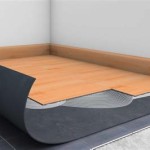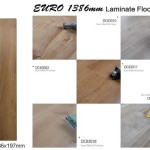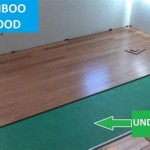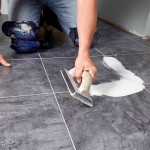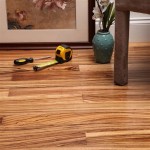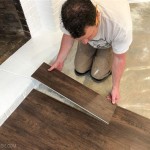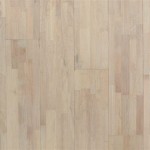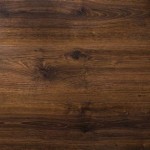How To Get Super Glue Off Of Laminate Floor Tiles
Laminate flooring offers a durable and aesthetically pleasing surface that mimics the look of hardwood, stone, or tile, making it a popular choice for many homes and businesses. Its affordability and ease of installation contribute to its widespread use. However, accidents happen, and one common mishap involves the accidental application of super glue to a laminate floor. Super glue, also known as cyanoacrylate adhesive, is prized for its rapid bonding and strong hold. While these qualities make it useful for various repairs, they present a significant challenge when it comes to removing it from surfaces like laminate. Attempting to scrape or forcefully remove super glue can damage the laminate's protective layer, leaving behind unsightly scratches or dull patches. Therefore, a meticulous and patient approach is necessary to safely and effectively remove super glue from laminate floor tiles.
The composition of laminate flooring plays a crucial role in determining the appropriate removal methods. Laminate typically consists of several layers, including a core made of high-density fiberboard (HDF) or medium-density fiberboard (MDF), a decorative layer that provides the visual appearance, and a protective wear layer. This wear layer is vital for resisting scratches, stains, and fading. Harsh chemicals or abrasive tools can compromise this layer, leading to permanent damage and diminished appearance. Therefore, selecting a removal technique that is gentle yet effective is paramount.
Before commencing any removal process, it is essential to identify the type and extent of the super glue spill. A small, isolated drop may respond well to simple techniques, while a larger, more widespread spill may require a more involved approach. Furthermore, the age of the glue spill affects its solubility. Freshly applied super glue is generally easier to remove than glue that has had time to fully cure and harden. Therefore, prompt action can significantly improve the success rate of the removal process.
Safety precautions are also necessary before beginning. It is advisable to wear gloves to protect the skin from potential irritants or solvents used during the removal process. Adequate ventilation is also recommended, especially when using chemical solvents, to minimize the inhalation of fumes. If the individual is sensitive to chemicals, a respirator mask may be beneficial. Prior to applying any cleaning solution to the entire affected area, it is crucial to test the solution on an inconspicuous area of the laminate floor to ensure that it does not cause discoloration or damage. This precautionary step can prevent further damage and ensure the chosen method is safe for the particular type of laminate flooring.
Key Point 1: Utilizing Non-Abrasive Methods for Initial Removal
The first line of defense against super glue on laminate should always involve non-abrasive methods. These techniques prioritize gentle removal to minimize the risk of scratching or damaging the laminate's surface. One effective method involves applying heat directly to the glue. A hairdryer, set on a low to medium heat setting, can be used to soften the adhesive. The heat should be applied for a few minutes, directing the airflow over the glue spot. The goal is to soften the glue's bond with the laminate, making it easier to lift without causing damage. Once the glue has softened, a plastic scraper or a credit card can be carefully used to gently pry the glue away from the surface. It is crucial to avoid using metal scrapers or sharp objects, as these can easily scratch the laminate. The scraper should be held at a low angle and moved in short, controlled strokes, working from the edges of the glue spot towards the center. Patience is essential, as rushing the process can lead to damage.
Another non-abrasive method involves using a damp cloth. A clean, soft cloth dampened with warm water can be placed over the super glue spot for several minutes. The moisture helps to weaken the glue's bond, making it easier to remove. After soaking the area, the same plastic scraper or credit card technique can be employed to gently lift the softened glue. This method is particularly effective for smaller glue spots or for glue that has not fully hardened. In some cases, the glue may simply peel away with the damp cloth after sufficient soaking.
In cases where the glue is particularly stubborn, a combination of heat and moisture can be used. Applying heat with a hairdryer followed by soaking with a damp cloth can further soften the glue and improve the chances of successful removal without abrasion. It is important to continually assess the laminate's surface for any signs of damage during the process. If any scratching or discoloration is observed, the method should be immediately discontinued, and an alternative approach should be considered.
Key Point 2: Employing Solvents for Stubborn Super Glue
When non-abrasive methods prove insufficient, solvents can be considered to dissolve the super glue. However, caution is paramount when using solvents, as some can damage laminate flooring. Acetone, commonly found in nail polish remover, is a frequently recommended solvent for removing super glue. However, it is crucial to test acetone on an inconspicuous area of the laminate first to ensure that it does not cause discoloration, dulling, or other damage. If the test area shows no adverse effects, acetone can be carefully applied to the super glue spot.
To apply acetone safely, soak a cotton ball or a clean cloth with acetone and gently dab it onto the super glue. Avoid rubbing the acetone, as this can spread the glue and potentially damage the surrounding laminate. Allow the acetone to sit on the glue for a few minutes to allow it to penetrate and soften the adhesive. After a few minutes, gently try to lift the softened glue with a plastic scraper or a credit card. Repeat the process if necessary, reapplying acetone and allowing it to soak for additional time. It is important to work in a well-ventilated area when using acetone, as the fumes can be strong and potentially irritating.
Another solvent that can be considered is isopropyl alcohol. Like acetone, isopropyl alcohol can dissolve super glue, but it is generally less aggressive and may be safer for use on laminate flooring. The same testing procedure should be followed to ensure that the isopropyl alcohol does not damage the laminate. If it is deemed safe, apply it to the glue spot with a cotton ball or cloth, allow it to soak, and then gently scrape away the softened glue. Mineral spirits can also be used, but they are typically stronger than isopropyl alcohol and should be used with extra caution. Always test any solvent in an inconspicuous area first.
Regardless of the solvent used, it is crucial to thoroughly clean the affected area after the super glue has been removed. Use a clean, damp cloth to wipe away any residual solvent. Follow this with a dry cloth to remove any remaining moisture. This helps to prevent the solvent from lingering on the laminate and potentially causing damage over time.
Key Point 3: Addressing Residue and Restoring the Laminate's Appearance
Even after successfully removing the bulk of the super glue, a sticky residue may remain on the laminate floor. This residue can attract dirt and debris, making the area appear unsightly. Several methods can be used to remove this residue and restore the laminate's appearance. One approach involves using a mild detergent solution. Mix a small amount of dish soap with warm water and use a soft cloth to gently wipe the affected area. Avoid using excessive water, as this can seep into the seams of the laminate and cause damage. After wiping with the detergent solution, rinse the area with a clean, damp cloth to remove any soap residue.
Another method for removing residue involves using a specialized laminate floor cleaner. These cleaners are formulated to be gentle on laminate surfaces while effectively removing dirt, grime, and sticky residues. Follow the manufacturer's instructions for application, ensuring that the cleaner is safe for use on the specific type of laminate flooring. Typically, the cleaner is sprayed onto the floor and then wiped away with a clean mop or cloth.
In some cases, a baking soda paste can be used to remove stubborn residue. Mix baking soda with a small amount of water to create a thick paste. Apply the paste to the residue and gently rub it in a circular motion with a soft cloth. The baking soda acts as a mild abrasive, helping to lift the residue. After rubbing, wipe away the paste with a damp cloth and then dry the area thoroughly.
After removing the residue, it may be necessary to restore the laminate's shine. A laminate floor polish or restorer can be used to enhance the appearance of the flooring and protect it from future damage. These products are typically applied with a mop or cloth and allowed to dry according to the manufacturer's instructions. Regular maintenance, including sweeping or vacuuming to remove dirt and debris, can help to prevent future super glue spills from becoming a major problem. Proper care will extend the life of the laminate flooring and maintain its aesthetic appeal.

How To Remove Glue From Laminate Flooring

How To Remove Super Glue From Laminate Flooring 14 Steps

How To Remove Super Glue From Laminate Flooring 14 Steps

Easily Remove Super Glue From Any Surface With This Household Staple

Removing Glue Or Adhesive From Hardwood Floors The Speckled Goat

Best Ways To Take Out Even Impossible Remove Glue From Floors

How To Remove Super Glue From Laminate Flooring 14 Steps

Removing Glue Or Adhesive From Hardwood Floors The Speckled Goat

How Can I Get Super Glue Off Of My Laminate Floor Help Hometalk

Housekeeping Tips How To Get Glue Off Of Hardwood Floors
See Also
